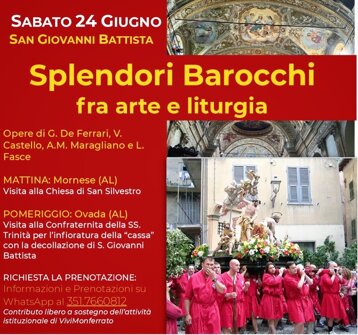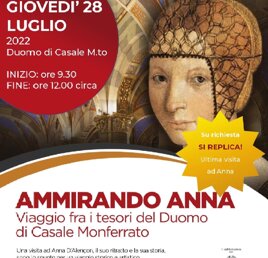ATS ViviMonferrato ETS
Località Piano 32/B, 15070 Lerma, AL
CF:90028290063 - RUNTS: Rep. n° 3040
cell: 351-7660812
IBAN: IT42 M035 7601 6010 1000 3949146
Sezzadio: St. Giustina and St. Stefano
The conversation we are proposing continues the brief excursus of Romanesque churches with Gothic influences in the Alessandria area.
S. Stefano: the small church was part of a Benedictine convent that depended on the Abbey of S. Stefano in Genoa, of which it was a grange.
The entire complex was later acquired by Cistercian nuns who moved there from Bano, near present-day Tagliolo Monferrato, for safety reasons. The church had two pictorial interventions in the 14th and 15th centuries, the most visible of which now is the one commissioned by the nuns.
S. Giustina: the imposing abbey church belonged to a large Benedictine convent complex probably founded as early as the end of the 8th century. It was certainly expanded and decorated by Otberto, Aleramic marquis, around the first half of the 12th century. Both architecturally and pictorially, it has peculiarities that make it a rare piece in the Piedmontese and Lombard territory.
Both churches are opened on request, so it is not easy to visit them normally. Take advantage of the opportunity!
As always, the meeting is open to all members.
NOTE FOR THOSE WHO WISH TO JOIN AT THE TIME
The 2024 membership fee is €10 and is valid for the whole year.
As always, you are all kindly asked to communicate your participation in advance to the usual number: 351 7660812
Meeting at 2:30 pm, Church of S. Stefano, Via Roncarino 26, Sezzadio (AL)
A large parking lot is right in front of the church

Past events



FOURTEENTH-CENTURY PAINTING
Places involved: Cassine, Church of St. Francis
Description: Cassine preserves in its oldest core a rare example of Lombard-style Gothic. As evidence of the strong bond between the Cassine community and the Franciscan friars for about 6 centuries, the Church of San Francesco has in its very 'bones' the traces of all this historical, architectural, and artistic experience. On this special occasion, we will discuss the initial phases of its journey, from its foundation to the creation of the first frescoes. Franciscan spirituality, as in other mendicant orders, brings with it principles, symbols, and specific features that are still partly visible in the architecture and art of the church's early decades.
Places involved: Mornese and Ovada
Description: On the occasion of the Ovada Festival of San Giovanni, we propose a short route between the two villages (10 km apart) to discover works from the mid-17th century in Baroque style.
Morning: at 10:00 am we will meet at the parking lot of the Mornese schools to begin the short journey towards the parish church of San Silvestro. Passing under the imposing walls of the Doria Castle, we will enter what was once the Ricetto and, going up via Chiesa, we will reach the panoramic square in front of the typically seventeenth-century structure. From here the detailed visit begins. Inside, we will be able to observe the oldest features of the church and the subsequent renovations, as well as works by De Ferrari, Castello, and Fasce.
Afternoon: at 2:00-2:30 pm we will move towards Ovada (with our own means) and reach the small square in front of the loggia of San Sebastiano. Here is the oratory of the SS. Trinità and preparations will be underway for the solemn mass and the procession (starting at 5:00 pm). We will talk about the history of the confraternity, the fortunate purchase of the "cassa" by Maragliano which can be admired as it will be displayed outside. If possible, we will visit the oratory and its treasures and see the vestments used by the confraternity on solemn occasions. For those who wish, it will be possible to participate in the mass and the subsequent procession. The cassa weighs more than a ton and a half and is carried by hand through the historic center of Ovada. This festival, of Genoese tradition, is very heartfelt in Ovada due to its ancient belonging to the Republic of Genoa.
Finally, it is customary for the confraternity to organize the so-called "Raviolata". It will therefore be possible to eat in the square (for a small contribution).
A short distance from the Via Postumia and at the foot of the first spurs of the Apennines, Gavi has for centuries observed and controlled the passage of soldiers, merchants, and pilgrims. People who for centuries have passed through to go to war, to the Crusades, on pilgrimage, in search of work in the majestic and wealthy Genoa, or to bring their goods from the plains to the sea and vice versa. Descending from the mountains or coming from Arquata if the route, the season, greater safety, or the need for a stop required it, it would have been here, in Gavi, that they would have passed through. The small village lying on the banks of the Lemme river and watched over by the great fortress behind it has experienced moments of great significance over the centuries. In our visit, we will focus on two of the identifying elements of this history: the Fortress and the Church of San Giacomo Maggiore.
Morning: San Giacomo Maggiore
We propose a cultural “walk” in medieval Gavi, with a particular focus on the Church of San Giacomo Maggiore, a Romanesque jewel unique in Upper Monferrato. Starting from the hypothesis that San Giacomo also arose as a stop on one of the medieval routes to Santiago de Compostela we will highlight its possible clues. We will consider the different construction styles and their references to the craftsmen working both in Liguria and Lombardy, but not only. The historical role of Gavi as a transit hub between the plains and the sea will lead us to support the possibility that Burgundian influences reached here.
We will observe the pictorial works preserved inside in their stylistic and historical evolution, with particular attention to the triptych by Gandolfino da Roreto. A work perhaps less known compared to the more famous ones in Asti, Quargnento, Savigliano, and Alessandria.
Afternoon: The Fortress
The existence of a defensive fortification could date back to the Byzantine era necessary to stem the first barbarian invasions. Currently, the structure of the fortress develops on several levels and with numerous buildings surrounded by powerful bastions. Over the centuries it has been a fortress, marquis castle, delegation house, district prison, and a prison camp both in the First and Second World Wars. It dominates the entire Lemme valley and thanks to this position and the protective and reinforcement works carried out over the centuries, it is a massive and imposing fortress that has never actually been conquered.



Places involved: Cathedral of St. Evasio, Cathedral Museum, Library of the Curia of Casale Monferrato
Description: Taking advantage of the still brief presence of the portrait of Marchioness Anna d’Alençon at the Cathedral Museum, the reserved visit will focus on some architectural and artistic treasures contained in the cathedral, its museum, and the Historical Room of the Library of the Curia Palace, formerly the episcopal seminary.The first part of the visit will take us to the matronea of the vestibule in front of the portal of the Church of St. Evasio (12th century). We will be able to observe the decorative details, the figures of the medieval bestiary and the fragments of contemporary frescoes. We will then move inside the cathedral where, high up in front of the presbytery, we will be greeted by the Christus Triumphans. The great crucifix (12th century) seized by Facino Cane from the Alexandrians in 1403 is a sort of unicum in its kind due to its particular artistic and constructive characteristics. Passing through the corridor leading to the Cathedral Museum, we will pause at the fragments of mosaics that made up the original flooring of the Cathedral, built on a pre-existing church dedicated to St. Lawrence erected by Liutprand, Lombard king (8th century). We will then arrive at the Cathedral Museum to appreciate the portrait of Anna d’Alençon and learn about some aspects of the intense life of this courageous, intelligent, and shrewd woman. We will then move to the building of the former Episcopal Seminary, now the seat of the Curia, and specifically to the Historical Room of the Library. The Room is a wonderful example of an eighteenth-century library.
Places involved: Church of Our Lady of the Assumption and Episcopal Palace
Description: The Triptych of the Virgin of Montserrat signed by “Bartolomeus Rubeus”, known as Bartolomé De Cardenas, is to be considered, all things considered, the highest expression of art that the city of Acqui preserves. The Triptych is located in the Chapter Hall and is accessible upon request and only in the presence of the Cathedral volunteers.
Our visit aims to tell the story that brought the Triptych to Acqui at the beginning of the 16th century as a testamentary bequest from the patron, Francesco Della Chiesa. We will see what Francesco's story was, his role and that of his family in Acqui, and we will also get to know the artist and the peculiar characteristics of Bartolomé's pictorial style—a forerunner in Spain of oil painting. For those who do not know the Cathedral, it will also be an opportunity to discover its beauties.
Acqui Terme has been an episcopal seat since the 5th century thanks to the work of Saint Maggiorino and, presumably, a first basilica was founded by him in the name of the Virgin Mary.
Over the centuries, the Romanesque structure has evolved into what we can now admire with a clear Baroque imprint, but remnants of its original simplicity are still visible.
The visit, in fact, includes the narration of the history of the Cathedral, the Crypt where the remains of Saint Guido rest, who consecrated it in 1067, and the Cloister with the marble artifacts present there. The visit will be guided by the volunteers of the Cathedral and ViviMonferrato.
Places involved: Silvano d'Orba, Sanctuary of San Pancrazio
Description:We are starting the 2023 season with this outdoor event.
The municipality of Silvano d'Orba has very ancient origins thanks to its strategic position as an access point to the plain at the confluence of two rivers, the Orba and the Piota. It preserves the remains of a Roman castrum, ruins of the Roccaforte degli Zucca, the first lords of Silvano (11th century), the Botta Adorno Castle (15th century, currently inhabited), and numerous churches of considerable historical and artistic interest.
The day is divided into two separate visits:
MORNING:
A walk of about 6 km on the hills overlooking the town up to the Sanctuary of San Pancrazio and back to the starting point. During the walk, there will be stops at points of historical and naturalistic interest. We will be accompanied by friends from the local cultural association "Ir Bagiu" who will tell us about the history of Silvano and the local flora according to the current blooms.
AFTERNOON:
In the pleasant hamlet of the Pieve, amidst gardens and vineyards, there will be a guided tour of the church of S. Maria della Neve. The ancient parish church to which all the villages in the area referred. Of Romanesque origin, it underwent several embellishments especially in the 16th and 17th centuries. It preserves remarkable 17th-century paintings on the life of the Madonna. In front of the church stands a massive medieval tower house.
ATS ViviMonferrato ETS
Località Piano 32/B, 15070 Lerma, AL
CF:90028290063 - RUNTS: Rep. n° 3040
cell: 351-7660812
IBAN: IT42 M035 7601 6010 1000 3949146

